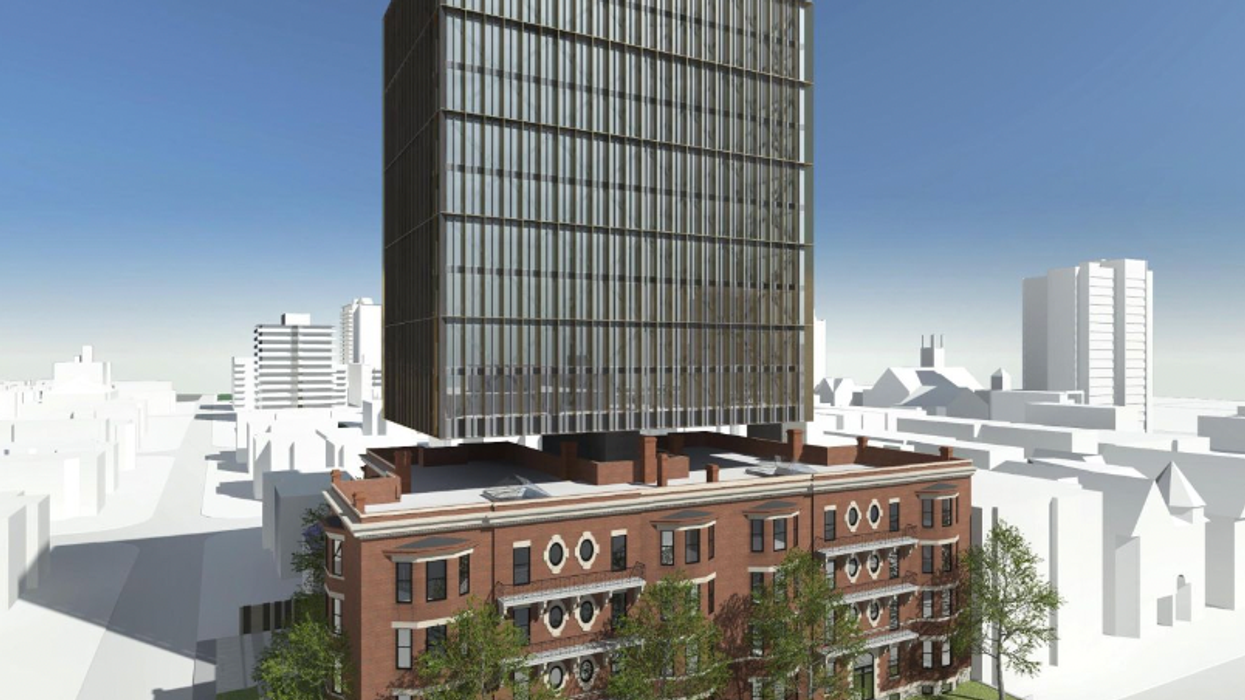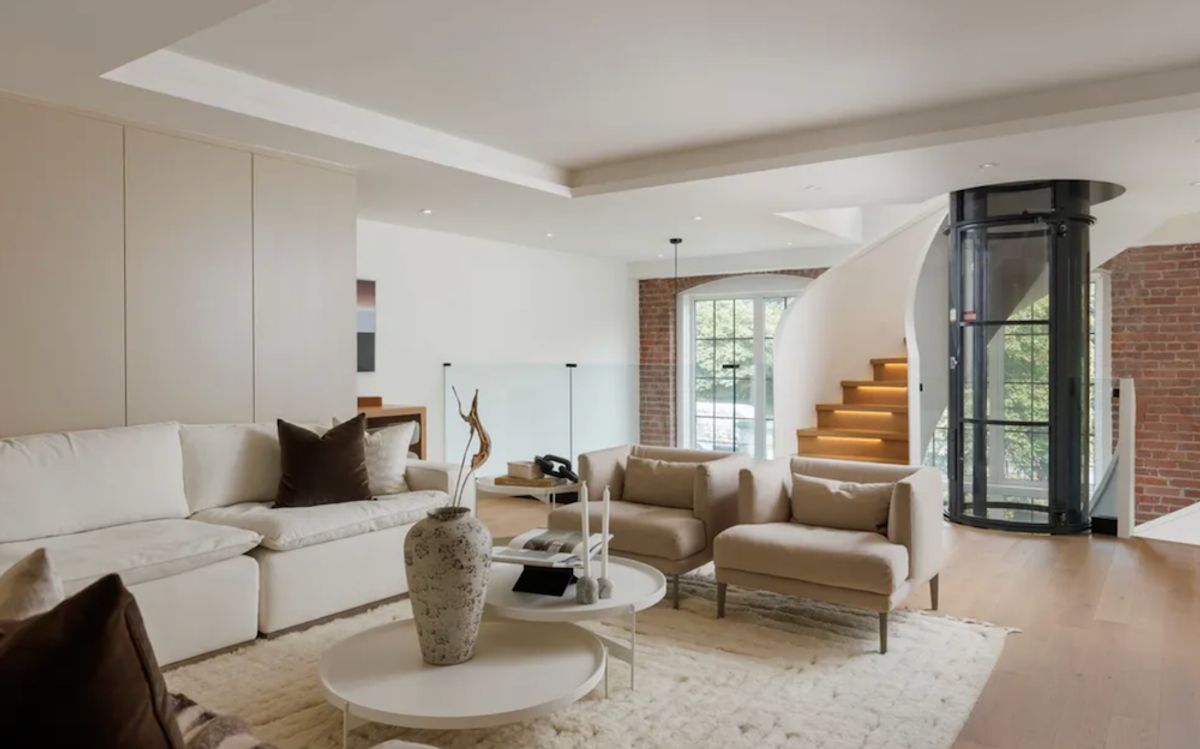Last week, City Council approved a Zoning By-Law application to build a 10-storey floating addition on top of Spadina Gardens — a classic example of Edwardian architecture and one of Toronto's oldest apartment buildings.
As a part of the Dutch developer ProWinko's building plans, the construction of the 10 floating storeys above 41-45 Spadina Avenue is intended to be pulled off without tenants having to be evicted and without any damage or change to the heritage building below.
The Spadina Gardens was completed in 1905 and, over the years, has become a beloved Annex neighbourhood landmark. The building is visited by ROM tours, architects, and architecture students, and even starred as the subject of a documentary called "Charlotte's Castle," which will be celebrated as a nominee at the Heritage Toronto Awards later this month.
The documentary follows the tenants of Spadina Gardens as they ward off 'renovictions' from ProWinko, with the tenants being led by Charlotte Mickie, who has lived in the building for over 30 years and serves as the President of the Spadina Gardens Tenants Association (SGTA).
At a September 25 Toronto and East York Community Council Meeting, Mickie spoke on behalf of the SGTA, with support from the Annex Residents' Association (ARA), in hopes of amplifying tenants' concerns, which have bloomed in the absence of adequate reassurance from ProWinko.
Among a number of concerns expressed by Mickie and in letters from the SGTA and ARA is the fact that a construction project like this is "unprecedented," the tenants have not been made aware of the potential impact of construction on their health and safety, there are no clear plans for how the heritage building will be preserved, and it has not been made clear if the existing units will lose sunlight and ventilation as a result of the addition.
Top of mind for the tenants is whether or not a construction project like this can even be pulled off.
"The core issue is that the residents have a high degree of anxiety and the applicant has, to date, not offered much to alleviate this anxiety," said the ARA letter authored by Elizabeth Sisam and Henry Wiercinski, Co-chairs of the Planning + Development Committee. "The situation falls into the Donald Rumsfeld’s rubric of ‘known knowns,' 'known unknowns,' and 'unknown unknowns.' The concerns expressed by the residents are in the 'known unknowns' category. They very much feel that they are pawns in an experiment. For them this is not an academic exercise."
In hopes of gaining some clarity and maintaining peace of mind as the project progresses — and they are in favour of it progressing — the Spadina Gardens tenants requested that a construction management plan be provided that is acceptable to tenants who are expected to shelter in place, steps be outlined for what to do if it becomes impossible to safely live below the construction site, an engineering study to confirm adequate access to natural light and ventilation, along with a Vibration Impact Study and Construction Impact Study, amongst other provisions.
But, the issues, which largely surround the construction of the building, were raised during the zoning application phase, when, often, details like these are deferred to the site plan approval stage, to be considered at a later date — a process which Mickie disagrees with.
"Apparently, it's typical for applications to pass zoning with issues deferred to site planning, permitting, etc.," she said during deputations. "But in this case, that order of events seems to be counter-intuitive — to defy common sense."
Councillor Dianne Saxe (University-Rosedale) empathized with Mickie and lamented Council's inability to provide them with more answers. "I've heard from the Annex residents association and from the tenants: 'why are we approving the zoning before we know for sure that this thing can be built? [...] But we just don't have the legal authority to make sure all those Ts are crossed and Is are dotted right now. The City will do that before we allow this building to be built, but we do not have the legal right to do it now."
In an effort to further bring the Spadina Gardens residents into the fold on this ambitious development, Councillor Saxe brought forth a motion requiring "Development Review staff to consult with existing tenants and the applicant throughout the site plan and building permit process with respect to outstanding concerns, especially those related to construction impacts."
As well, council requested that City Planning consider securing a number of environmentally-friendly building improvements, outdoor seating, and a shift from a Type-G loading area to a Type-C loading area (providing increased accessibility for wheel trans and for ambulances), as part of the site plan agreement.
The motions were approved along with the zoning application by City Council on October 9, but residents continue to be apprehensive about the project.
"I am kind of excited about it. I think it could be really innovative, but I wouldn’t say we were wildly in favour of it because we have so many worries," Mickie told STOREYS. "It is a brick and mortar building, and there’s no exact precedent for the kind of construction they’re proposing, but anything in Toronto that’s even come close has been a building that had steel girder construction, so I just want everyone to be very diligent and keep an eye on what’s going on."
Mickie also told STOREYS she was pleased with the motions adopted by Council, but says, "when I look at what did pass, I do have some questions about whether perhaps [...] there could have been another amendment to consider securing, for example, things like the vibration impact study."
But despite red flags raised by tenants, it should be noted that according to a City staff member at September's meeting, "The application meets the intent of the official plan, all city divisions that have reviewed it have provided their feedback and all are in alignment that it’s a good application, we have a corresponding heritage report that’s also recommending approval, and we have the rental housing application, where housing is also recommending approval.”
Though, as Councillor Saxe put it, “This is a remarkable application in that it proposes to evict no one and to preserve virtually all of an extremely valuable heritage building. And those are great things," she says. "It does mean that if we’re not evicting the tenants, they are going to live there during construction. And anyone who’s lived through a construction project can tell you there is no pleasure in living though a construction project."
- A Soaring 3-Tower Development Is Headed For Flemingdon Park ›
- Revised Plans Add 33 Storeys To Heritage Building Near Queen West ›
- Annex Residential Development Could Add 10 Floating Storeys To Historic Apartment Building ›
- 14-Storey Mixed-Use Development Proposed For Mount Pleasant ›
- Futuristic Development Could Bring 1,782 Units To Front St ›





















